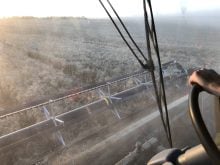Glyphosate resistant weeds are causing major headaches for farmers in many parts of the world, says an Australian weed expert.
“It was originally thought that glyphosate resistant weeds would be very rare. There were examples in the first 25 years of its use where we had people deliberately go out and select such weeds,” Ian Heap told a recent meeting at Manitoba Ag Days in Brandon.
“The first glyphosate resistant weed, rigid ryegrass, was found in 1996 in Australia. Ryegrass species tend to evolve resistance quite quickly.”
Read Also

U.S. bill could keep out Canadian truckers
The Protecting America’s Roads Act, which was tabled in the U.S. House of Representatives at the beginning of October, would “rid the country of illegal immigrant commercial truck drivers and ineligible foreign nationals.”
Other examples include horseweed, which is getting tougher to kill in North America, and Johnson grass, which is becoming a problem in
Argentina.
Many other weed species have lately come to the attention of researchers, added Heap, who is the organizer of the International Survey of Herbicide Resistant Weeds.
First reported in Delaware in 2000, glyphosate resistant conyza, commonly known as horseweed, has since appeared in many states and now can be found on more than half a million acres.
“I wouldn’t doubt that it is already here in Canada,” he said. “It’s been identified in North Dakota already.”
Horseweed has evolved resistance to many herbicide modes of action in the past. Its tiny seeds, spread by wind, have made it the most widespread, rapidly expanding resistant weed.
The solution to glyphosate resistance is to use stronger doses of the chemical, Heap said.
“In the past with the Group 1 and Group 2 resistant weeds, the ACCase and ALS inhibitors, we saw target site resistance and very high levels of resistance – in some cases 50-fold. With glyphosate resistant weeds, we are seeing generally a very low level of resistance.”
Before glyphosate resistance began to appear, Heap’s weed survey assembled a top 10 list of worst offenders, which included wild oats, red root pigweed, lamb’s quarters, foxtail, barnyard grass, kochia and smooth pigweed.
“Not surprisingly, the first three glyphosate resistant weeds had also appeared in that top 10. So we may expect some of these other bad players to become resistant, too,” he said.
Of the top 20 herbicide resistant weeds, 30 percent are pigweeds. Two pigweed types have shown resistance to glyphosate.
“I would warn you to be careful if treating pigweeds with any herbicides repeatedly year after year,” he said. “I’d be looking at rotating herbicide modes of action.”
Heap showed a slide of a field in the southern United States, which had many Roundup resistant pigweed plants dwarfing a thin stand of cotton.
“That’s a very major issue for them down there right now.”
In other countries, such as Australia, where there is multiple resistance to many different herbicides, producers are going back to using paraquat.
In Chile and South Africa, farmers are countering resistance by adding a Group 1 herbicide, or ACCase inhibitor, to the glyph-osate for greater killing power.
“Where people get glyphosate resistance, they are not throwing away glyphosate, they are adding other modes of action,” said Heap.
The problem is not as common in Canada, where the only Roundup Ready crop is canola.
However, in the U.S., where a variety of RR crops are grown, problems are starting to emerge, he said.
“In the corn-soybean belt, they are going to start evolving many, many herbicide resistant weeds, and they will have to start adding back in the old modes of action along with a few new ones. They are going to be back to square one where they were 10 years ago before the advent of Roundup Ready products,” he said.
To prevent glyphosate resistance, Heap urged farmers to use full rates of the chemical when spraying. Be on the lookout for trouble spots, and if they appear, try other approaches.
“Cutting rates may increase the likelihood of selecting for these low-level, translocation mechanisms of resistance,” he said.
“Glyphosate is relatively inexpensive, so use full rates.”
The danger of glyphosate resistant weeds is in allowing them to spread, he added, because weeds under normal circumstances rarely develop resistance to the chemical.
“They may appear only on one farm and spread from that farm. Glyphosate resistant weeds may happen only once or twice in an area the size of Manitoba and spread out from there.”
















